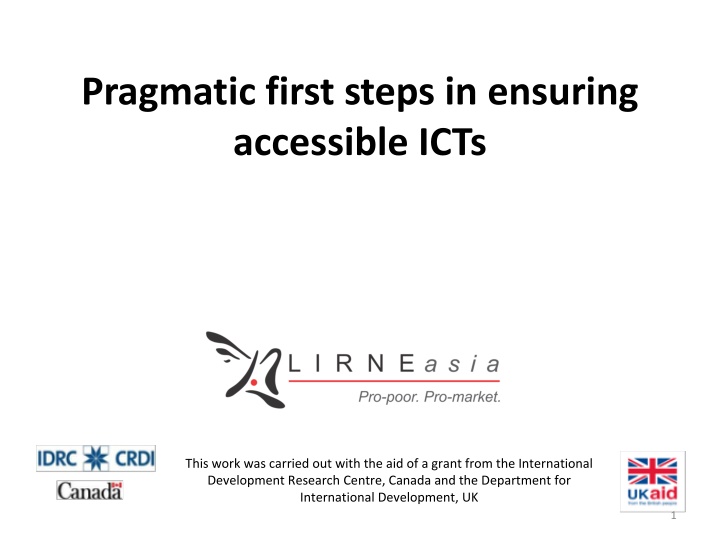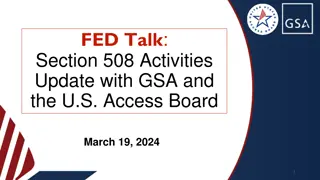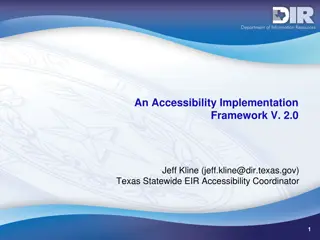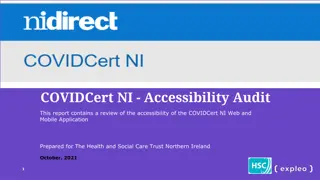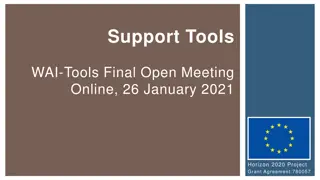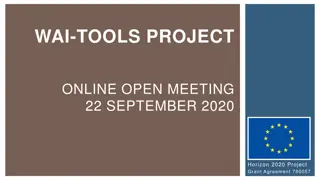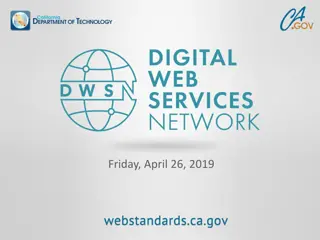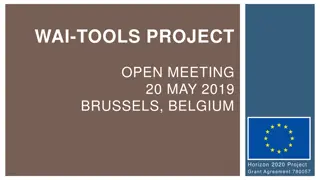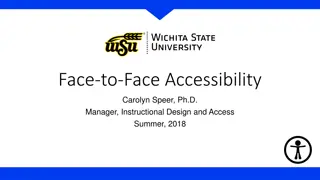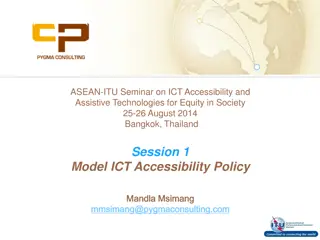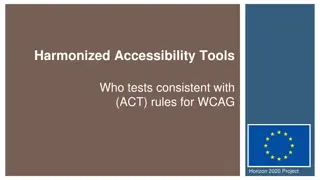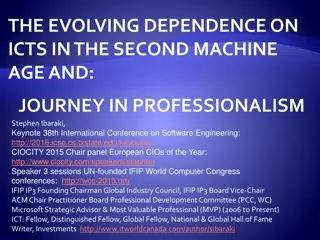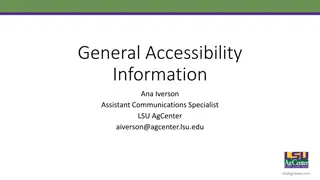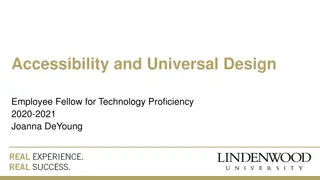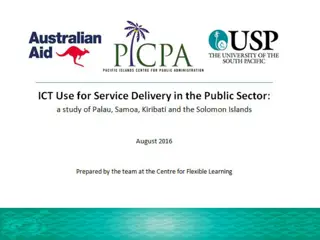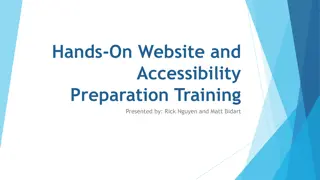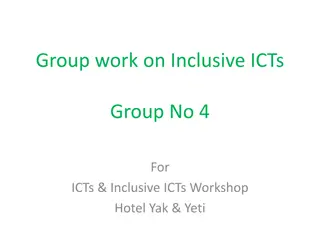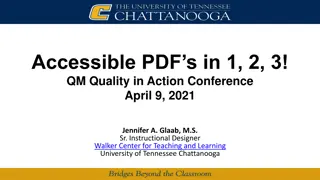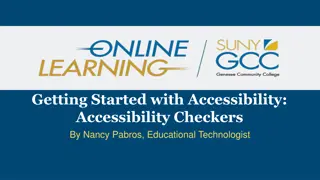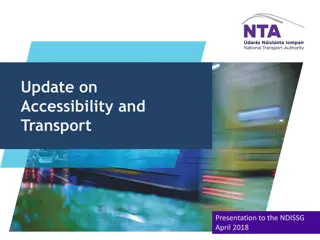Enhancing Accessibility in ICTs with International Support
Explore initiatives in Nepal and beyond aimed at ensuring accessibility in ICTs, with a focus on the usage of smartphones among individuals with disabilities. Data highlights the significance of smartphones in enhancing the internet experience in various regions. Additionally, learn about the proactive steps taken by companies like AT&T to address access and aging issues through advisory panels.
Uploaded on Sep 24, 2024 | 0 Views
Download Presentation

Please find below an Image/Link to download the presentation.
The content on the website is provided AS IS for your information and personal use only. It may not be sold, licensed, or shared on other websites without obtaining consent from the author.If you encounter any issues during the download, it is possible that the publisher has removed the file from their server.
You are allowed to download the files provided on this website for personal or commercial use, subject to the condition that they are used lawfully. All files are the property of their respective owners.
The content on the website is provided AS IS for your information and personal use only. It may not be sold, licensed, or shared on other websites without obtaining consent from the author.
E N D
Presentation Transcript
Pragmatic first steps in ensuring accessible ICTs This work was carried out with the aid of a grant from the International Development Research Centre, Canada and the Department for International Development, UK 1
Smartphones and the disabled in Nepal Granular details not readily available Lots of different claims LIRNEasia is collecting disabled data through a large-sample survey in Nepal in 2018 Smartphones are becoming cheaper Nepal s take up will increase over time 2
Data from the region. Smartphones are a crucial component of a good Internet experience Type of mobile owned (% of mobile owners) 100% 90% 80% 70% 60% 56% 54% 49% 48% 50% 42% 37% 40% 28% 30% 26% 24% 22% 20% 16% 12% 10% 0% India Pakistan Bangladesh Cambodia Basic Feature phone Smartphone Q: What type of mobile is it? Multiple responses allowed [1] basic phone [2] feature phone [3] smartphone (Multiple Response) Base Argentina South Africa Guatemala India Nigeria Pakistan Bangladesh Cambodia Kenya All respondents 1,500 1,208 1,517 5,069 1,808 2,002 2,020 2,123 1,208 3
EXAMPLES OF ACTIONS BY OPERATORS 4
US: AT&T set up advisory panel on access and aging The panel composed of national leaders in assistive technology, aging and cross-disability issues. It provides advice and counsel to AT&T's subsidiaries, affiliates and leadership teams regarding issues of mutual interest. AAPAA meets semiannually to discuss a specific area of the business with guest speakers & corporate subject matter experts. Members John Anschutz-Manager, Assistive Technology Center Shepherd Center Kelly Buckland Executive Director, National Council on Independent Living (NCIL) Yanira Cruz, PhD, President & CEO National Hispanic Council on Aging Lise Hamlin, Director of Public Policy Hearing Loss Association of America Lee Huffman, AccessWorld and Technology Information Editor American Foundation for the Blind Angela Jones, SVP Business Development & Lifestyle AARP Services Inc. Ben Lippincott, Manager, Industry Relations Wireless RERC Linda Mastandrea CEO Law Offices of Linda Mastandrea Alfred Moye' Board of Directors SeniorNet Jason Resendez Executive Director, UsAgainst Alzheimer's Latino Network Latinos Against Alzheimer's Coalition Gloria Satriale, Esq. Executive Director, Preparing Adolescents and Adults for Life (PAAL) President, Mission for Educating Citizens for Autism Claude L. Stout Executive Director Telecommunications for the Deaf and Hard of Hearing, Inc. (TDI) Amy VanDeVelde National Connections Program Manager The OASIS Institute Source: AT&T website 5
AT&T has accessibility plans for deaf/hard of hearing and for those with speech disability Voice calling is not their primary mode of communication. These plans are for customers who mainly use text messaging or video calling. How to apply for AT&T Accessibility plans Customers interested in the AT&T Text Accessibility plan (TAP) must qualify by completing the Text Accessibility Plan (TAP) Application and Certification Form (PDF, 342KB). TAP plans are available for all versions of iPhone. Source: AT&T website 6
Whats in it for operators? Different markets segments have to be addressed: disabled persons constitute different market segments Emotional payoff from assisting disabled communities 7
ACTIONS BY REGULATOR/GOVERNMENT 8
Primary focus Address the information asymmetry Executives in telcos know intuitively about the needs of abled individuals They need to learn about the needs of the disabled Special attention to mechanisms that improve communication between the disabled and operators 9
Use of consultative committees are encouraged by US regulator The Federal Communication Commission (FCC) Consumer Guide- Telecommunications Access for People with Disabilities states Companies should engage in a number of activities to identify barriers to accessibility and usability. For example: When conducting market research, product design, testing, pilot demonstrations and product trials, companies should include individuals with disabilities in target groups for such activities. Companies should work cooperatively with disability-related organizations. Companies should undertake reasonable efforts to test access solutions with people with disabilities. Source: Consumer Guide- Telecommunications Access for People with Disabilities. Federal Communications Commission 10
Hong Kong: Consultative approach and publicity also required Consultation and Co-operation Obligatory Requirements 20. Fixed operators, PSPs, mobile telephone operators, paging operators and internet service providers should consult and co-operate with the CA to ensure that the needs and interests of the elderly and people with a disability are fully taken into account in the development and provision of telecommunications services and apparatus specified in the Code. Publicity Obligatory Requirements 21. Fixed operators, PSPs, mobile telephone operators, paging operators and internet service providers should ensure that the measures which they take in order to comply with the obligatory requirements of this Code are widely publicized, taking into consideration the need to disseminate information in appropriate formats and through appropriate channels for the elderly and people with a disability. Source: Guidelines given by the Office of the Communications Authority-Hong Kong 11
Malaysia: Local call/toll free number for ease of making complaints for those with physical disabilites recommended Source: General Consumer Code of Practice for the Communications and Multimedia Industry Malaysia (2003) Communications and Multimedia Forum of Malaysia, MCMC 12
Regulator commissoned studies to assess information provided to consumers with disabilities on products designed for them 35% mentioned services spontaneously, 75% after prompted Source: Ofcom (2010) Disabilities Mystery Report 13
Excerpt from draft universal service strategy of Myanmar Improved access and usability of various ICT services for disabled people: the USF will work with notable representative disability groups to identify specific barriers and requirements from persons with disabilities in regards to using ICT services; initial indications are that there are already, for example, several helpful applications for both blind and deaf people but that they only exist in English and need to be converted into the Burmese language. 14
Nepals unimpressive performance with universal service The government has spent only 2.6 per cent of the money accumulated in Rural Telecommunications Development Fund (RTDF) in the last 17 years. This shows that a huge amount of resources has remained idle in the fund, which was supposed to be utilised for extending telecom services to rural areas. As of March-end, Nepal Telecommunications Authority (NTA) collected a total of Rs 10.22 billion for RTDF from income of its licensees till last fiscal. Each licensee of NTA contributes two per cent of their annual income from services in RTDF that was established as per a provision in Telecommunications Act 1997. The Act says the fund has to be used for making telecom services available in rural areas . So far, Rs 265.69 million has been paid to Nepal Telecom (NT) and Rs 2.95 million to Subisu Cable Net from the fund for their involvement in service expansion to rural and remote areas. 15
The difference now In the old days, we had to rely on operators and regulators for everything Now we can do things on our own, with the help of well designed apps that can exploit the potential of the smartphone 16
